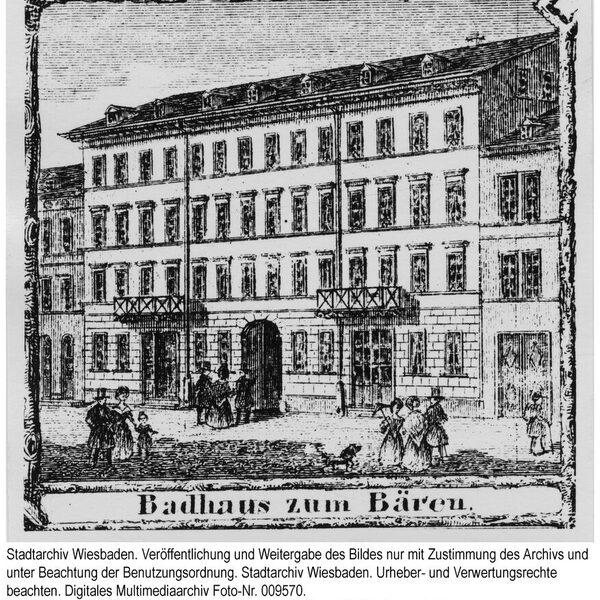Hotel Bären
The Hotel Bären was one of the oldest and best-known hotels in Wiesbaden on today's Langgasse. The first records date back to 1471 and in the 16th century it was the preferred hostel for guests of the Counts of Nassau. In 1725-28, a new building was erected, which extended backwards to the Mühlgraben (near today's Dreililien-Platz). In addition to the bathhouse with side wing, a large and a small bath and stables for 80 horses were built. Goethe stayed at the Hotel Bären in 1814 and 1815.
From 1840, the Bär had 110 rooms and a conversation room and, with its 60 baths fed by the Adler spring, offered numerous other spa treatments in addition to steam and shower baths. A spring in the garden also made it possible to offer drinking cures.
In 1890, the town bought the Hotel Bären. The hotel complex was demolished. In 1912, a new building was erected in the lower part of Bärenstraße, which was taken over in 1926 by hotelier August Bödecker, who came from Antwerp, and his wife Petronella. After partial destruction during the Second World War, Karl Bödecker rebuilt the Hotel Bären. Its front now faces the newly created Dreililienplatz.
In the 1950s and 1960s, the Hotel Bären became the preferred hostel for film and television stars such as Heinz Rühmann and Marika Rökk. In 1973, the hotel was given a new thermal, swimming and exercise pool, including a solarium.
The Hotel Bären was closed at the end of 2015.
Literature
Czysz, Walter: Vom Römerbad zur Weltkurstadt, Geschichte der Wiesbadener heißen Quellen und Bäder, Wiesbaden 2000 (Schriften des Stadtarchivs Wiesbaden 7) [p. 96; 103; 314].
Kurt, Thomas: A piece of Wiesbaden history. From the inn "Zum Schwarzen Bären" to the "Hotel Bären". In: Wiesbadener Leben 11/1976 [p. 12 f.].
Schaller, Detlef/Schreeb, Hans Dieter: Kaiserzeit. Wiesbaden and its hotels in the Belle Epoque, Wiesbaden 2006 [p. 87].
